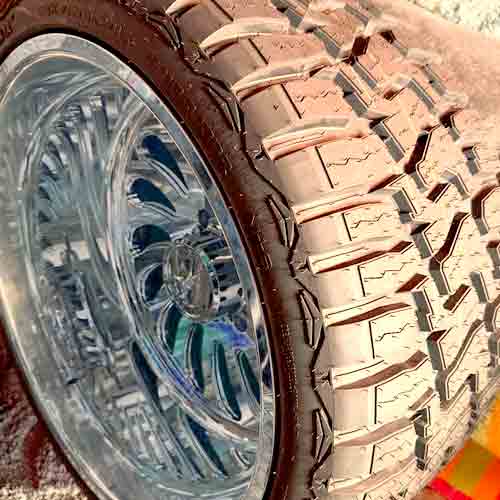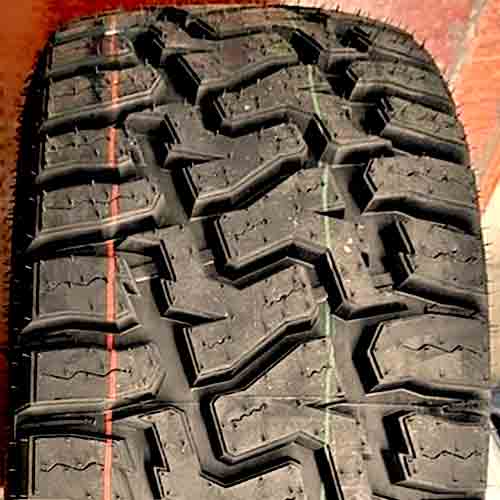The Haida HD878 RT, as the name suggests, is a rugged terrain tire, so it’s off-road traction is better than your average A/T, while on pavements, it would almost definitely outperform any mud terrain tire. Let’s take a closer look at this dude!

In my expert opinion as a tire engineer, the Haida HD878 RT features decent directional grip, but lacks in the handling department. Though its steering feedback is still very responsive. Moreover, the tire offers decent traction on snow, sand, mud and rocks. And despite having such balder structure, it keeps its road noise at bay as well.
Tire Sizes
Haida HD8378 comes in 17 to 24 inches with following specs.
- Speed ratings: S, Q and T.
- Load ratings: SL, XL, C, D, E and F.
- Tread depth range: 14 to 18/32″.
- UTQG: 500 AB.
All sizes don’t offer any treadwear warranty, and you also don’t get the winter rating of 3 peak mountain snowflake.
Though all sizes have M+S on them.
Tread Appearance
The Haida HD878 RT looks very similar to the Toyo M/T. Let me explain its tread.

Starting from the middle, here you see 2 very biting L shaped blocks forming interlocking pattern with each other.
These lugs have sharp edges, especially towards the shoulders, sideways facing notches, and reinforced foundations underneath them.
Moreover, you also see squiggly siping on these blocks too. Though it could get improved, (as you’d see in the upcoming topics).
Moving towards shoulder lugs, although you get the same tread features here, these blocks are thicker and form slightly better siping pattern.
And of course towards their outer edges they form thick sidewall lugs, joining up the staggered shoulders.
Tread Life
When it comes to tread life, the Haida HD878 RT tire, known for its durable construction, offers commendable performance, no doubt. Let me explain why in the following points.
- Its single nylon cap ply design keeps its weight at bay, promoting even wear and reducing the force with which the tire rolls on the surface.
- Its stiff (enough) composition is less susceptible to wearing off quickly, while comparing other MTs out there.
- And its 18/32″ tread depth enhances its overall longevity, which takes a while coming down to 2/32″ of legal limit.
Though you should know that this tire doesn’t boast the same tread depth as some of its competitors like the Mickey Thompson MTZ, but its stiffer compound and durable construction, combined, still contribute to a treadwear performance that should satisfy a majority of users.
Ride Quality
As a hybrid tire, the Haida HD878 RT makes compromises in highway comfort, due to its smaller silica compound composition, which does not absorb bumps on paved roads as effectively as others in the market.
And adding to that are the tire’s stiffer cap plies that limit the flexibility further, compromising not only vibrations settling abilities but steering response as well.
Nonetheless, the tire makes up for it with it’s good enough noise reduction capabilities.
Although the Haida HD878 RT features wide lug gaps that can generate considerable noise as air moves around and strikes the tread, it is still relatively quiet compared to other rugged terrain tires.
This is primarily due to the tire’s excellent variable pitch technology, which helps counteract noise.
Typically, a tire with larger tread voids produces more noise, but with variable pitch technology, air particles striking different parts of the tread create various tones at different areas. These distinct frequencies work to cancel each other out, effectively dampening noise very effectively.
Dry Performance
Dry performance depends on two things, the tire’s footprint meeting with the ground, and its rubber composition.
Greater rubber meet-up results in superior lateral and directional grip, while the tread composition gives you an idea about steering response.
Let’s look at all of these elements separately.
Directional Grip
As the name suggest, its the grip of a tire while it rolls straight. That’s why it gets calculated with braking distances.
And Haida HD878 with it’s fat lugs in the middle offer above-average performance. If you scroll up to its tread section above, you’d know that its blocks are although a little bald, they form an interlocking pattern with each other thanks to their L-shaped design.
Moreover, these lugs also have secondary rubber supports underneath constituting a harder rubber.
Both of these features allow this tire to still provide an above average performance, comparing other rugged terrain tires.
Dry Handling
Handling also depends on the footprint of a tire, but from shoulders. That’s why Haida R/T isn’t able to provide a good enough performance here.
Being a hybrid, it carries shoulder lugs of a mud-terrain tire (while its middle stays A/T), and so with such voided block design, the grip is naturally compromised.
Though the good thing about this tire, is it’s steering response. It’s overall structure is lighter (compared to other R/Ts), so its shows up with a good enough under/over steering balance, relatively.
Though these things are different in the handling section.
Wet Traction Performance
Generally hybrid tires aren’t so great on wet pavements. And the Haida HD878 is no exception here. Sure its a decent tire in case of hydroplaning, but other than that, it really lacks in providing grip at a micro level, that comes form sipes.
Basically, most of the water leaves the tread through voids, while the rest have to be cleaned off with sipes.
So it makes sense why Haida is pretty lacking here overall, with minimal siping.
Snow Performance
The performance of a tire in snowy conditions is assessed based on its ability to provide stability during braking, maintain control when turning, and effectively accelerate on both shallow and deep snow, as well as ice.
And testing the the tire with above mentioned variables, it can be seen why Haida does not get to have 3 peak mountain snowflake (3PMSF) rating.
The 3PMSF rating basically tells that a tire would have at least 10% better acceleration values compared to average all-season tires, though it not everything.
While the Haida HD878 RT does not hold this severe winter rating, it still offers decent traction compared to other hybrid tires on the market. This is attributed to its specially designed sipes for snow.
For example, its shoulder lugs feature thick, full-depth slits on the edges that grip on snow particles, providing decent handling capabilities.
And its interlocking central lugs structure is designed to grab and hold snow within the grooves, creating snow-to-snow exposure and improving traction.
Durability
Rugged-terrains being the most extreme versions of AT tires, provide solid inner architecture. And the Haida HD878 isn’t an exception.
The comes with 3 ply polyester casing with two full width steel belts made out of steel cords (much stronger than used in A/Ts).
And all of these layers are then wrapped by a single nylon cap ply, adding to the overall durability and concreting stability.
Mud Performance
The Haida HD878 RT, being a hybrid tire is equipped with mud-terrain-like outer lugs, which allows it to deliver ample mud traction.
It’s outer circumferential rings are enough to channel all sorts of clay and wet debris out without any hurdles, while its sharp notches and off-set edges break down the mud particles (so they can evacuate out easily).
Moreover, its staggered shoulder blocks include mud scoops, which, in combination with the sidewall lugs, enable the tire to extract itself out, even when deeply submerged in mud.
Rock Traction
My go-to tire for rocky terrains has always been the Nitto Ridge Grappler (review). However, after experiencing the capabilities of the Haida HD878 RT, I’m not so sure anymore, as its rock-crawling abilities are also very impressive.
Among all the hybrid tires I’ve reviewed, some of the best ones for rocky terrains include the Mickey Thompson Baja Boss AT (review), Maxxis Razr AT811, and of course, the Nitto Ridge. But now I’m also adding the Haida HD878 RT to this list.
The tire’s staggered shoulders deliver exceptional gripping power, while its sidewall lugs provide confidence-inspiring climbing abilities (especially when the air pressure is lowered).
Simply reduce the tire’s pressure to a lower PSI and watch it tackle almost all sorts of rocky terrains with ease.
Sand Traction
Sand is a challenging terrain type, that requires both excellent driving skills and a suitable tire.
But what is a suitable tire here? Well, a tire with sufficient tread footprint, lighter weight, and a softer outer structure is.
And considering these variables, it can be understood why why the Haida HD878 RT encounters some difficulties in here, particularly on slopes, where its larger weight hinders efficient forward momentum.
However, with reduced air pressure, the tire’s sidewall lugs and staggered shoulders help increase the tire’s footprint, significantly improving traction.
Additionally, you can confidently lower the tire’s pressure, as its robust rim locks ensure the tire remains securely in place, preventing the bead from rolling off.
So all in all, its safe to say, you won’t be disappointed with the tire’s performance here.
Summary
The Haida HD878 RT is a versatile hybrid tire with satisfactory performance across various terrains.
The tire although looks very similar to Toyo Open Country RT, it’s very different in terms of performing at different key areas.
Having said that its tread life, comfort, and noise levels are adequate for a tire of this category.
And it performs well on deep snow, rocks, and sand, making it a suitable option for off-road enthusiasts seeking a budget-friendly hybrid tire.